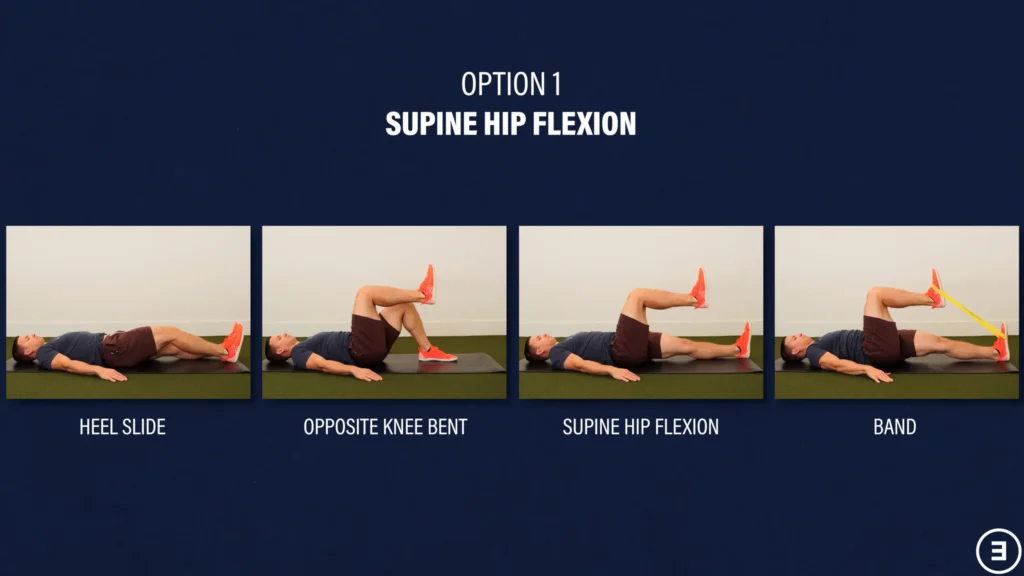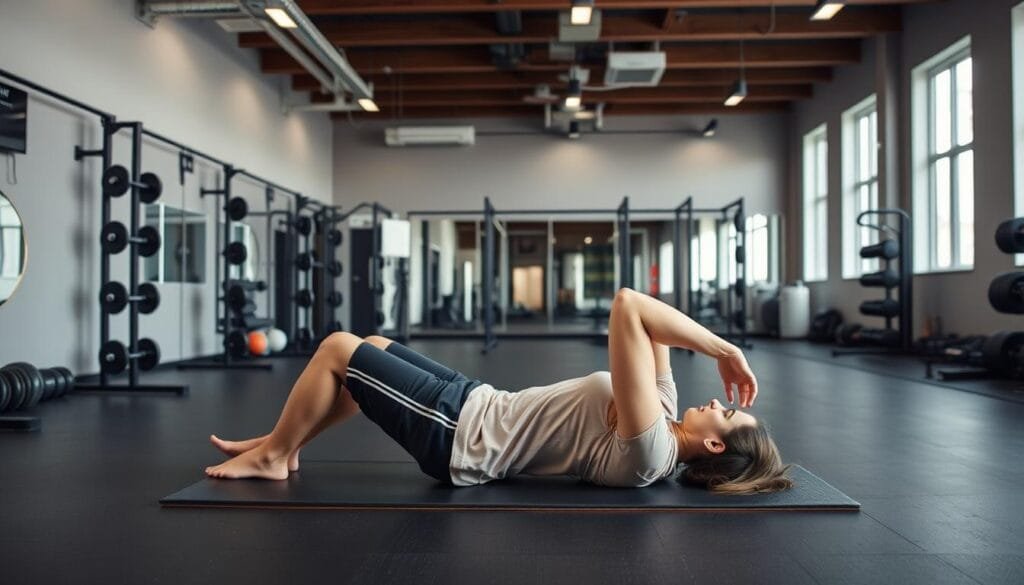Ever thought a simple move could change your fitness game? The weighted lying to standing exercise is more than a trend. It’s a way to boost your mobility and strength. This exercise can make daily tasks easier.
This article explores the weighted lying to standing exercise. It shows its benefits and how it can fit into your life. You’ll see why mobility matters for fitness and how to get stronger with this exercise.
Key Takeaways
- The weighted lying to standing exercise enhances mobility and strength.
- This exercise is ideal for those looking to improve movement quality.
- Regular practice can lead to significant mobility improvement in everyday activities.
- Incorporates isometric exercises that require minimal equipment.
- Recommended for individuals in recovery or seeking a fresh workout approach.
- Progressive adaptations are available for various skill levels.
Introduction to the Weighted Lying to Standing Exercise
The weighted lying to standing exercise boosts your fitness routine. It works many muscles, improving strength and coordination. This exercise helps you smoothly move from lying down to standing while holding weights.
Adding mobility exercises like this to your routine is key. It enhances flexibility and daily movement. People find that these exercises strengthen the body and improve daily tasks.
Over 27,269 users have tried weighted neck extension exercises. They see the value in adding weighted movements to their workouts. Doing 8-12 reps for 3-4 sets targets important muscles. It’s good for both newbies and seasoned athletes.
Start by trying weighted lying neck extensions or seated versions. Pay attention to your form and avoid mistakes. Using the right weight is crucial for safety and effectiveness.
Learning the weighted lying to standing exercise can make your workouts better. It focuses on strengthening all major muscles. This makes your fitness journey safe and effective.
Understanding Mobility and Its Importance
It’s key to know about mobility and flexibility to boost your physical performance. Mobility definition talks about how well joints can move. Flexibility definition is about muscles stretching. Understanding these differences helps in making better training plans for you.
Definition of Mobility vs. Flexibility
Mobility is about how well your joints and muscles move together. It’s about muscle actions that help joints move better. Flexibility is about how far a joint can move when muscles are active. Both are important for your body to work well and recover from injuries.
Benefits of Improved Mobility
Getting better at mobility has many benefits. It:
- Improves how well you do in sports and daily tasks.
- Helps prevent injuries by making your body more resilient to stress.
- Increases how far your joints can move, which is good for joint health.
Being more mobile means you move better in sports and everyday life. It makes your body and muscles work together more smoothly. This keeps you flexible and healthy, which is great for living well.

| Aspect | Mobility | Flexibility |
|---|---|---|
| Definition | Ability to move joints through their full range | Ability of muscles to stretch and lengthen |
| Key Function | Controls joint motion and movement patterns | Affects muscle length and tension |
| Importance | Enhances performance and reduces injury risk | Supports basic movements and stability |
Key Benefits of the Weighted Lying to Standing Exercise
The weighted lying to standing exercise boosts your physical abilities and quality of life. It strengthens muscles, improves coordination, balance, and stability. These are key for staying fit and active.
Enhanced Muscle Strength and Coordination
This exercise works on big muscle groups like the legs, glutes, and core. It builds strength and coordination. By adding resistance, you get stronger for daily tasks.
It also makes you better at moving and performing tasks. This is great for your physical skills.
Improvement in Balance and Stability
As we get older, balance and stability become more important. The exercise challenges your balance, keeping you steady. This helps prevent falls and injuries.
| Benefit | Description |
|---|---|
| Muscle Strength | Targets major muscle groups, enhancing overall strength essential for daily activities. |
| Coordination Improvement | Enhances the ability to perform tasks requiring the coordination of different muscle groups. |
| Balance Improvement | Promotes better balance, reducing the risk of falls and injuries. |
| Stability Training | Improves core stability, crucial for maintaining control during various movements. |
| Functional Fitness | Enhances overall fitness levels, aiding in everyday functional movement. |
How to Perform the Weighted Lying to Standing Exercise
Getting ready for the weighted lying to standing exercise is key. Start with warm-up techniques to boost your performance and avoid injuries. We’ll look at the best ways to prepare and the steps to follow.
Essential Warm-Up Techniques
Warm-up exercises get your body ready for the workout. They increase blood flow and make sure your joints are ready. Here are some good warm-ups:
- Arm swings
- Leg swings
- Spinal rotations
These exercises focus on the muscles you’ll use in the weighted lying to standing. They help get you ready for the best performance.
Guided Exercise Steps
Here’s how to do the weighted lying to standing exercise right:
- Start by lying on your back with weights in your hands.
- Engage your core to stabilize your body.
- Gradually lift your torso while keeping your back straight.
- Push through your legs to move into a standing position.
- Make sure you keep the right form to avoid straining your joints.

Keeping the right form is crucial. Take your time to get each step right before adding weight. This way, you get the most out of the exercise and stay safe.
Weighted Lying to Standing Exercise Variations
Trying different versions of the weighted lying to standing exercise can really boost your workout. It doesn’t matter if you’re a beginner or looking for a challenge. These exercise modifications will help you get the most out of your workout while staying safe.
Adjustments for Beginners
Beginners need special versions of the exercise. Start by using less weight. Or, practice without weights to get used to the movement. Sitting down first can help you build strength and confidence before trying the full exercise.
Advanced Techniques for Experienced Users
For those who have been exercising for a while, there are ways to make the exercise harder. Use resistance bands or heavier weights to increase the challenge. You can also try moving faster from lying to standing. This not only makes the exercise more intense but also improves your coordination and heart health. By always trying new things, your workouts will stay interesting and effective.

Incorporating the Weighted Lying to Standing Workout into Your Routine
Adding the weighted lying to standing exercise to your weekly routine boosts your fitness. It works many muscles at once and lets you rest between sessions. A structured plan helps you stay on track and reach your fitness goals.
Sample Weekly Workout Plan
Here’s a sample weekly plan with the weighted lying to standing exercise:
| Day | Workout | Description |
|---|---|---|
| Monday | Weighted Lying to Standing | Focus on 2-3 sets of 10-12 reps. |
| Wednesday | Mobility & Core | Incorporate bird-dog and Turkish get-up exercises. |
| Friday | Weighted Lying to Standing | Repeat with increased weight or reps for challenge. |
| Saturday | Cardio & Strength | Combine exercises like squats and dead bugs. |
Combining with Other Exercises for Maximum Benefits
To get the most out of your workouts, mix different exercises. Here are some good ones to add:
- Squats: Boost leg strength and engage your core.
- Lunges: Improve balance and work your glutes and thighs.
- Upper Body Exercises: Try weighted front raises and neck extensions for stronger shoulders.
By mixing these exercises, you keep making progress and avoid getting stuck. Always try to add more weight or change your routine. This way, you work out different muscles, making your training more complete and effective.

Safety Considerations for the Weighted Lying to Standing Exercise
Doing the weighted lying to standing exercise can boost your mobility. But, safety comes first. Knowing the risks and following safe practices is key for a good workout. This way, you can enjoy the exercise’s benefits without getting hurt.
Common Injuries and How to Avoid Them
When you do the weighted lying to standing exercise, watch out for injuries like strains or sprains. These often happen in the lower back and knees. Here are some tips to prevent injuries:
- Start with lighter weights to gauge your comfort level.
- Maintain proper exercise form at all times to ensure body alignment.
- Pay attention to your body’s signals; listen to it and stop if you feel unwell.
- Focus on controlled movements, as hasty actions can lead to injuries.
Proper Form and Technique
Keeping the right form is crucial for safe and effective exercise. Here are some tips:
- Engage your core throughout the exercise to support your lower back.
- Keep your knees in line with your toes to avoid unnecessary strain.
- Perform each repetition slowly and with control, ensuring stability.
- Incorporate regular feedback, such as using a mirror or practicing alongside a partner.

By following these safety tips, you can safely do the weighted lying to standing exercise. This will help improve your mobility and fitness.
Comparison with Other Mobility Exercises
Looking at other exercises can help us see how they improve mobility. We can compare the weighted lying to standing exercise with standing to lying down with weights and lying down to standing with resistance. Each one has its own way of boosting physical function and mobility.
Standing to Lying Down Exercise with Weights
The standing to lying down exercise with weights works similar muscles as the weighted lying to standing routine. It’s great for improving mobility with weights. Adding weights makes it better for coordination, muscle growth, and mobility.
Many people find it helpful for building stability and strength. These are key for staying fit.
Lying Down to Standing with Resistance
The lying down to standing with resistance is a bit tougher. It requires more core strength and stability. This makes the workout more intense and boosts functional fitness.
Adding this to your routine can make your workouts more varied and effective. With regular practice, you’ll likely see big improvements in mobility and balance.
| Exercise | Muscle Engagement | Core Stability | Resistance Training Benefits |
|---|---|---|---|
| Standing to Lying Down Exercise with Weights | High | Moderate | Improves strength and coordination |
| Lying Down to Standing with Resistance | Very High | High | Boosts functional fitness and balance |
Real-Life Applications of the Weighted Lying to Standing Exercise
The weighted lying to standing exercise has many uses in daily life. It works on muscles needed for common actions like standing up and sitting down. This exercise helps make everyday tasks easier and more manageable.
Getting up from the floor becomes easier with this exercise. It’s a big help as you get older or face physical challenges. It makes you more independent and improves your quality of life.
This exercise also helps with other physical activities. For example, lifting groceries or playing with kids needs strong muscles. The weighted lying to standing workout gets you ready for these activities, linking workouts to real-life tasks.
Here’s a table showing how this exercise helps in daily life:
| Practical Application | Benefit | Impact on Functional Fitness |
|---|---|---|
| Getting up from the floor | Increased strength and stability | Enhances independence |
| Lifting objects | Improved muscle coordination | Facilitates everyday activities |
| Improved balance | Reduces fall risk | Supports mobility in daily tasks |
| Engaging in sports | Greater agility and endurance | Boosts performance |
Adding this exercise to your routine improves your health and boosts your confidence. You’ll find it easier to handle daily tasks.
Testimonials: Success Stories from Practitioners
Real experiences show how effective the weighted lying to standing exercise is. Here are inspiring stories from people who added this exercise to their fitness routines.
“After adding the weighted lying to standing exercise to my routine, I saw big improvements in my mobility and strength. It has changed my daily life for the better.” – A satisfied practitioner
People have shared their amazing transformations through their stories. They talk about how this exercise has greatly improved their lives:
- Lexlee Hudson lost 187 lbs in two and a half years starting in January 2018. This weight loss prepared her for the weighted lying to standing exercise.
- Linda Migliaccio lost 189 lbs with a nutritarian diet. This allowed her to easily do exercises that improve mobility.
- Ann Wulff lost 207 lbs with WeightWatchers and regular workouts. This greatly improved her mobility.
- Crystal Benes lost 100 lbs in 15 weeks with a local weight loss program. She continues to work out every day.
These stories show a common theme of resilience and determination. Each person’s dedication to changing their lifestyle has brought them better mobility and strength. Their stories highlight the value of finding exercises that match our goals.
Expert Recommendations for Enhancing Mobility
To boost your mobility, follow expert tips from top physiotherapists. They suggest adding mobility exercises like the weighted lying to standing move to your workout. These exercises help improve your functional fitness and performance.
Professional Tips from Physiotherapists
Physiotherapists say dynamic stretching is better than static stretching for warming up. Just ten minutes of dynamic stretching can make you run faster and jump higher. Here are some exercises and practices they recommend:
- Nerve Flossing: Do this for at least 3 minutes daily to ease pain and increase range of motion.
- Deep Belly Breathing: Lie face-down on the floor and breathe deeply to calm your nervous system.
- Single-Leg Supine Leg Raise: This exercise targets your hip flexors. Do 2 sets of 10 reps.
- Cossack Squat: Focuses on your glutes and quads. Do 2 sets of 6 reps.
- Thoracic Foam Rolling: Roll your thoracic spine for 3 rounds of 30 seconds to improve shoulder and spinal mobility.
| Exercise | Target Area | Recommended Sets/Reps |
|---|---|---|
| Dynamically Stretching | Full Body | 10 minutes prior to workout |
| Inchworms | Hamstrings, Calves, Hips | 3 rounds of 5-10 reps |
| Lunges with “World’s Greatest Stretch” | Thoracic Spine, Hips | 1 on each side with deep breaths |
| PVC Passes | Shoulders, Upper Back | 10 lifts |
| Band Pullovers | Shoulders, Ribs, Spine | 3 rounds of 10-15 reps |
Adding these exercises to your routine can greatly improve your mobility and health. Always talk to a doctor before starting a new exercise program, if you have injuries or joint replacements.
Conclusion
The weighted lying to standing exercise is key for better mobility and fitness. It works many muscles, like the abs, obliques, and glutes. This not only makes your body stronger but also boosts balance and movement.
Adding this exercise to your routine helps a lot in daily tasks. You’ll feel more agile and capable in workouts and everyday activities.
Getting the exercise form right is crucial to get the most benefits and avoid injuries. Don’t use momentum or carry too much weight. Instead, focus on smooth movements and increase the weight slowly.
Sitting a lot is common today, but this exercise can help. It burns more calories and reduces health risks from sitting too long. Make it a part of your healthy lifestyle to see improvements in strength, mobility, and energy.
See the weighted lying to standing exercise as a key part of your fitness plan. It’s a step towards better health and well-being now and in the future.
FAQ
What is the weighted lying to standing exercise?
How can the weighted lying to standing exercise improve my mobility?
What muscles are engaged during this exercise?
How do I perform the weighted lying to standing exercise correctly?
Are there modifications available for beginners?
What are some advanced techniques for experienced users?
How often should I incorporate this exercise into my fitness routine?
What are the common injuries associated with this exercise?
Can this exercise be combined with other workouts for added benefits?
What are the practical applications of the weighted lying to standing exercise?
How can I assess my progress while incorporating this exercise?
Source Links
- Examples of Isometric Exercises: Try These to Bust Gym Boredom – https://www.healthline.com/health/fitness-exercise/isometric-exercises
- 7 Stability Exercises to Help You Build Functional Strength – https://www.onepeloton.com/blog/stability-exercises/
- Weighted Lying Neck Extensions with Head Harness – https://www.tidalflow.com/exercises/weighted-lying-neck-extensions-with-head-harness
- The Beginner’s Guide to Weight Training – https://www.menshealth.com/fitness/a27212209/beginners-guide-weight-training/
- ACE – Certified™: September 2023 – The Surprising Benefits of Performing Daily Mobility Exercises – https://www.acefitness.org/continuing-education/certified/september-2023/8429/the-surprising-benefits-of-performing-daily-mobility-exercises/
- Chapter 13 Mobility – Nursing Fundamentals – https://www.ncbi.nlm.nih.gov/books/NBK591828/
- Weighted Plate Standing Around the World: Guide, Techniques, Benefits, How to, Muscles Worked, Tips & Tricks | Fitwill – https://fitwill.app/exercise/6549/weighted-plate-standing-around-the-world/
- Weighted Plate Standing Lateral Raise: Guide, Techniques, Benefits, How to, Muscles Worked, Tips & Tricks | Fitwill – https://fitwill.app/exercise/6485/weighted-plate-standing-lateral-raise/
- Physical activity guidelines for older adults – https://www.nhs.uk/live-well/exercise/physical-activity-guidelines-older-adults/
- A Beginner’s Guide to Free Weight Exercises – https://www.healthline.com/health/fitness-exercise/free-weight-exercises
- How to Do the Side Lying Leg Lift – https://melioguide.com/osteoporosis-exercises/side-lying-leg-lift/
- Side Leg Raises Two Ways with Variations and Tips – https://www.healthline.com/health/side-leg-raises
- How to Do Side-Lying Hip Abductions: Techniques, Benefits, Variations – https://www.verywellfit.com/side-lying-hip-abductions-techniques-benefits-variations-4783963
- Weighted Plate Standing High Front Raise: Guide, Techniques, Benefits, How to, Muscles Worked, Tips & Tricks | Fitwill – https://fitwill.app/exercise/4847/weighted-plate-standing-high-front-raise/
- Weighted Standing Neck Extensions – https://www.tidalflow.com/exercises/weighted-standing-neck-extensions
- 10 Weighted Core Exercises That’ll Challenge Your Abs In a Whole New Way – https://www.onepeloton.com/blog/weighted-ab-workouts/
- Exercise for heart failure: tips for exercising safely – https://www.bhf.org.uk/informationsupport/heart-matters-magazine/activity/exercise-for-heart-failure
- Weight Training: Exercises, Safety, and More – https://www.healthline.com/health/fitness-exercise-weight-training
- Weight-Bearing Versus Nonweight-Bearing Exercise for Persons With Diabetes and Peripheral Neuropathy: A Randomized Controlled Trial – https://www.ncbi.nlm.nih.gov/pmc/articles/PMC3637853/
- The effect of the rehabilitation program on balance, gait, physical performance and trunk rotation in Parkinson’s disease – https://www.ncbi.nlm.nih.gov/pmc/articles/PMC5099372/
- How to Exercise with Limited Mobility – HelpGuide.org – https://www.helpguide.org/wellness/fitness/chair-exercises-and-limited-mobility-fitness
- Mobility Vs. Stretching: How They Are Different & Why It Matters – Physio Ed. – https://physioed.com/mobility-vs-stretching/
- Are Standing Abdominal Exercises More Effective Than Floor Ab Exercises? – https://cathe.com/are-standing-abdominal-exercises-more-effective-than-floor-ab-exercises/
- 7 Functional Movements: Progressions, Regressions and Modifying around Pain – Never Too Old to Lift – https://nevertoooldtolift.com/7-functional-movements/
- Get Inspired by These Incredible Weight-Loss Transformations – https://people.com/health/incredible-weight-loss-transformation-photos/
- Growing Stronger – Strength Training for Older Adults – https://www.cdc.gov/physicalactivity/downloads/growing_stronger.pdf
- Somatics Testimonials – Somatic Movement Center – https://somaticmovementcenter.com/somatics-testimonials/
- 5 Joint Mobility Exercises to Improve Flexibility and Function – https://www.healthline.com/health/fitness-exercise/joint-mobility-exercises
- The 12 Best Mobility Exercises, PT-Approved | BarBend – https://barbend.com/best-mobility-exercises/
- 4 Mobility Exercises to Improve Your Range of Motion – https://www.goldsgym.com/blog/improve-range-motion-4-mobility-movements/
- Weighted Leg Raises: A Detailed Analysis – https://www.fitbudd.com/post/weighted-leg-raises-a-detailed-analysis
- Standing burns more calories than sitting or lying – https://www.medicalnewstoday.com/articles/326309




